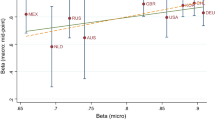Abstract
This paper considers some aspects of the dynamics of income distributions by employing a simple Markov chain model of income mobility. The main motivation of the paper is to introduce the techniques of “monotone” Markov chains to this field. The transition matrix of a discrete Markov chain is called monotone if each row stochastically dominates the row above it. It will be shown that by embedding the dynamics of the income distribution in a monotone Markov chain, a number of interesting results may be obtained in a straightforward and intuitive fashion.
Similar content being viewed by others
References
Atkinson AB (1970) On the measurement of inequality. J Econ Theory 2: 244–63
Atkinson AB, Bourguignon F, Morrisson C (1992) Empirical Studies of Earnings Mobility. Harwood, Chur
Bartholomew DJ (1982) Stochastic Models for Social Processes. 3rd Ed., Wiley and Sons, New York
Billingsley P (1961) Statistical Inference for Markov processes. University of Chicago Press, Chicago
Conlisk J (1985) Comparative statics for Markov chains. J Econ Dynamics Control 9: 139–51
Conlisk J (1990) Monotone mobility matrices. J Math Sociol 15: 173–191
Dardanoni V (1992) The Fiscal System and the Dynamic Redistribution of Income. In: Design and Reform of Taxation Policy. Galeotti G, Marrelli M (Eds), Kluwer, Dordrecht
Dardanoni V (1993) Measuring social mobility. J Econ Theory 61: 372–394
Dardanoni V, Forcina A (1993) You'd better have a rich father: Testing monotone mobility matrices. Mimeo
Lambert PJ (1993) The distribution and redistribution of income: A mathematical analysis. 2nd Ed., Manchester University Press, Manchester
Kanbur SMR, Stromberg J-O (1988) Income transitions and income distribution dominance. J Econ Theory 45: 408–416
Keilson J, Kester A (1977) Monotone matrices and montone Markov chains. Stochastic Process Appl 5: 231–241
Kemeny JG (1981) Generalization of a fundamental matrix. Linear Algebra Appl 38: 193–206
Kemeny JG, Snell JL (1976) Finite Markov Chains. Springer, New York
Kolm S-Ch (1969) The optimal production of social justice. In Public Economics. J Margolis, Guitton H (Eds), MacMillan, London
Shorrocks A (1976) Income mobility and the Markov assumption. Econ J 86: 556–578
Shorrocks A (1978) The measurement of mobility. Econometrica 45: 1013–1024
Author information
Authors and Affiliations
Additional information
Thanks are due to Peter Lambert and four anonymous referees for very helpful comments.
Rights and permissions
About this article
Cite this article
Dardanoni, V. Income distribution dynamics: monotone Markov chains make light work. Soc Choice Welfare 12, 181–192 (1995). https://doi.org/10.1007/BF00179833
Received:
Accepted:
Issue Date:
DOI: https://doi.org/10.1007/BF00179833




